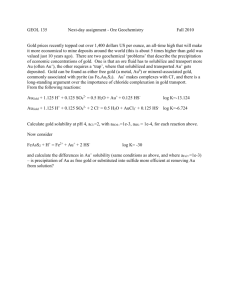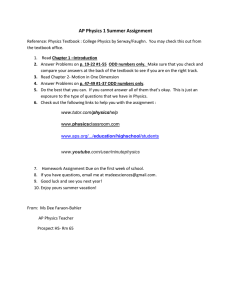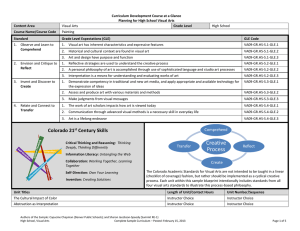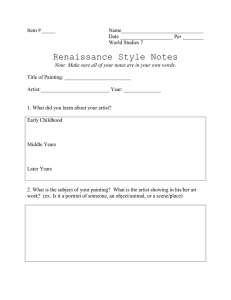Document 15590667
advertisement
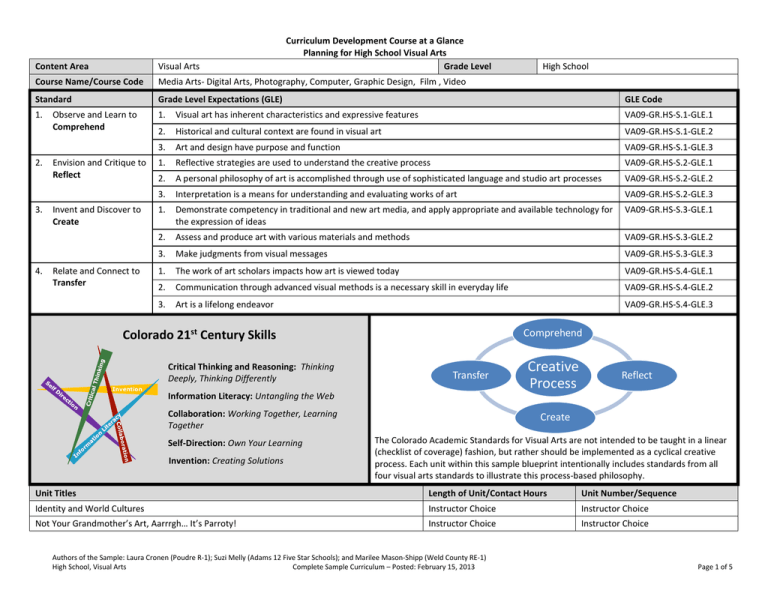
Curriculum Development Course at a Glance Planning for High School Visual Arts Grade Level Content Area Visual Arts Course Name/Course Code Media Arts- Digital Arts, Photography, Computer, Graphic Design, Film , Video Standard Grade Level Expectations (GLE) GLE Code 1. 1. Visual art has inherent characteristics and expressive features VA09-GR.HS-S.1-GLE.1 2. Historical and cultural context are found in visual art VA09-GR.HS-S.1-GLE.2 3. Art and design have purpose and function VA09-GR.HS-S.1-GLE.3 1. Reflective strategies are used to understand the creative process VA09-GR.HS-S.2-GLE.1 2. A personal philosophy of art is accomplished through use of sophisticated language and studio art processes VA09-GR.HS-S.2-GLE.2 3. Interpretation is a means for understanding and evaluating works of art VA09-GR.HS-S.2-GLE.3 1. Demonstrate competency in traditional and new art media, and apply appropriate and available technology for the expression of ideas VA09-GR.HS-S.3-GLE.1 2. Assess and produce art with various materials and methods VA09-GR.HS-S.3-GLE.2 3. Make judgments from visual messages VA09-GR.HS-S.3-GLE.3 1. The work of art scholars impacts how art is viewed today VA09-GR.HS-S.4-GLE.1 2. Communication through advanced visual methods is a necessary skill in everyday life VA09-GR.HS-S.4-GLE.2 3. Art is a lifelong endeavor VA09-GR.HS-S.4-GLE.3 2. 3. 4. Observe and Learn to Comprehend Envision and Critique to Reflect Invent and Discover to Create Relate and Connect to Transfer Colorado 21st Century Skills Critical Thinking and Reasoning: Thinking Deeply, Thinking Differently Invention High School Comprehend Transfer Creative Process Reflect Information Literacy: Untangling the Web Collaboration: Working Together, Learning Together Self-Direction: Own Your Learning Invention: Creating Solutions Create The Colorado Academic Standards for Visual Arts are not intended to be taught in a linear (checklist of coverage) fashion, but rather should be implemented as a cyclical creative process. Each unit within this sample blueprint intentionally includes standards from all four visual arts standards to illustrate this process-based philosophy. Unit Titles Length of Unit/Contact Hours Unit Number/Sequence Identity and World Cultures Instructor Choice Instructor Choice Not Your Grandmother’s Art, Aarrrgh… It’s Parroty! Instructor Choice Instructor Choice Authors of the Sample: Laura Cronen (Poudre R-1); Suzi Melly (Adams 12 Five Star Schools); and Marilee Mason-Shipp (Weld County RE-1) High School, Visual Arts Complete Sample Curriculum – Posted: February 15, 2013 Page 1 of 5 Curriculum Development Overview Unit Planning for High School Visual Arts Unit Title Identity and World Cultures Focusing Lens(es) Complexity Inquiry Questions (EngagingDebatable): Length of Unit Standards and Grade Level Expectations Addressed in this Unit Instructor Choice VA09-GR.HS-S.1-GLE.1, VA09-GR.HS-S.1-GLE.2, VA09-GR.HS-S.1-GLE.3 VA09-GR.HS-S.2-GLE.1, VA09-GR.HS-S.2-GLE.2, VA09-GR.HS-S.2-GLE.3 VA09-GR.HS-S.3-GLE.1, VA09-GR.HS-S.3-GLE.2, VA09-GR.HS-S.3-GLE.3 VA09-GR.HS-S.4-GLE.1, VA09-GR.HS-S.4-GLE.2, VA09-GR.HS-S.4-GLE.3 Why do various cultures experience and define identity differently in their art? (VA09-Gr.HS-S.1-GLE.1,2,3) and (VA09-Gr.HS- S.2-GLE.3) and (VA09Gr.HS-S.4-GLE.1) Can art reveal our values and beliefs? Why might artists consider the juxtaposition/relationship of the art elements within a composition to add “wow/pop” value, direct the viewer, and/or add emphasis? How is value/worth assigned to a culture’s art? Unit Strands Comprehend/Reflect/Create/Transfer Concepts Juxtaposition, Composition, Traditions, Culture, Relationships, Beliefs and Values, Identity, Expressive Features, Media, Variety Generalizations My students will Understand that… Guiding Questions Factual Conceptual Artists draw from their personal values, cultures, and traditions to create works of art that reflect their individual and cultural identity (Inspiration) (VA09-Gr.HSS.1-GLE.1,2,3) and (VA09-Gr.HS-S.2-GLE.1,2) and (VA09Gr.HS-S.3-GLE.1,2,3) and (VA09-Gr.HS-S.4-GLE.1,2,3) What media/materials might an artist use to express their individual identity? Why would an artist’s environment influence their art? Could an artist’s environment ever not influence their art? Explain. Artists use characteristics and expressive features of art to create a visual representation that reflects their identity. (Making) (VA09-Gr.HS-S.1-GLE.1,2,3) and (VA09-Gr.HSS.2-GLE.1,2) and (VA09-Gr.HS-S.3-GLE.1,2,3) and (VA09Gr.HS-S.4-GLE.1,2,3) How might an artist use line as an expressive element? What shapes or forms might you find in cultural traditions? Why would an artist use technology or new media to express individual identity rather than drawing or painting or other traditional media? Composition can reflect the complexity of an artist’s cultural identity. (VA09-Gr.HS-S.1-GLE.1,2,3) and (VA09Gr.HS-S.2-GLE.1,2) and (VA09-Gr.HS-S.3-GLE.1,2,3) and (VA09-Gr.HS-S.4-GLE.1,2,3) How do compositions from two or more cultures compare? How od complexity developed in these pieces? How can complexity be beautiful or ugly? What contributes to an individual’s interpretation/judgment of what is beautiful? Authors of the Sample: Laura Cronen (Poudre R-1); Suzi Melly (Adams 12 Five Star Schools); and Marilee Mason-Shipp (Weld County RE-1) High School, Visual Arts Complete Sample Curriculum – Posted: February 15, 2013 Page 2 of 5 Curriculum Development Overview Unit Planning for High School Visual Arts Artists juxtapose and/or alter cultural traditions and beliefs through a variety of media. (VA09-Gr.HS-S.1GLE.1,2,3) and (VA09-Gr.HS-S.2-GLE.1,2) and (VA09Gr.HS-S.3-GLE.1,2,3) and (VA09-Gr.HS-S.4-GLE.1,2,3) How does Wei Wei (insert artist) challenge his (her) cultural roots through art? How does the above artist’s work compare with other artists such as Sally Mann? How might an artist use juxtaposition between preconceived ideas/beliefs and artist intent to question perception? Why might an artist’s identity be different than that of their culture? Critical Content: Key Skills: My students will Know… My students will be able to (Do)… How to use characteristics and expressive features of art in new media and technology. (VA09-Gr.HS-S.1-GLE.1,2,3) and (VA09-Gr.HS-S.2-GLE.1,2,3) and (VA09Gr.HS-S.3-GLE.1,2,3) and (VA09-Gr.HS-S.4-GLE.1,2 ,3) How technology and new media can expand or personal voice. (Making) (VA09Gr.HS-S.1-GLE.1,2,3) and (VA09-Gr.HS-S.2-GLE.1,2,3) and (VA09-Gr.HS-S.3GLE.1,2,3) and (VA09-Gr.HS-S.4-GLE.1,2 ,3) Techniques to create complex and meaningful compositions in a variety of media, i.e. Media Arts- Digital Arts, Photography, Computer, Graphic Design, Film, YouTube, Video. (Making) (VA09-Gr.HS-S.1-GLE.1,2,3) and (VA09-Gr.HS-S.2GLE.1,2,3) and (VA09-Gr.HS-S.3-GLE.1,2,3) and (VA09-Gr.HS-S.4-GLE.1,2 ,3) How art functions as an agent of social and political change (VA09-Gr.HS-S.1GLE.1,2,3) and (VA09-Gr.HS-S.2-GLE.1,2,3) and (VA09-Gr.HS-S.3-GLE.1,2,3) and (VA09-Gr.HS-S.4-GLE.1,2 ,3) Use characteristics and expressive features of art to create a visual representation that reflects identity. (Making) (VA09-Gr.HS-S.1-GLE.1,2,3) and (VA09-Gr.HS-S.2GLE.1,2,3) and (VA09-Gr.HS-S.3-GLE.1,2,3) and (VA09-Gr.HS-S.4-GLE.1,2 ,3) Create art that reflects complexity of an artist’s cultural identity. (Making & Inspiration) (VA09-Gr.HS-S.1-GLE.1,2,3) and (VA09-Gr.HS-S.2-GLE.1,2,3) and (VA09Gr.HS-S.3-GLE.1,2,3) and (VA09-Gr.HS-S.4-GLE.1,2 ,3) Discuss how artist challenge and/or alter cultural traditions and beliefs. (VA09Gr.HS-S.1-GLE.1,2,3) and (VA09-Gr.HS-S.2-GLE.1,2,3) and (VA09-Gr.HS-S.3GLE.1,2,3) and (VA09-Gr.HS-S.4-GLE.1,2 ,3) Explain how art can be an agent of social and political change. (VA09-Gr.HS-S.1GLE.1,2,3) and (VA09-Gr.HS-S.2-GLE.1,2,3) and (VA09-Gr.HS-S.3-GLE.1,2,3) and (VA09-Gr.HS-S.4-GLE.1,2 ,3) Critical Language: includes the Academic and Technical vocabulary, semantics, and discourse which are particular to and necessary for accessing a given discipline. EXAMPLE: A student in Language Arts can demonstrate the ability to apply and comprehend critical language through the following statement: “Mark Twain exposes the hypocrisy of slavery through the use of satire.” A student in ______________ can demonstrate the ability to apply and comprehend critical language through the following statement(s): Artists create compositions using technology and new media that reflects personal voice within a larger cultural context. Academic Vocabulary: Beliefs and Values, Compositions, Traditions, Culture, Relationships, Identity, Perspective, Complexity, Technology, Social and Political Commentary, Justify, Investigate, Debate, Analyze, Document, Research, Interpret, Context, Influence, Differentiate, Compare and Contrast, Historical Significance, Articulate, Discern, Paradigm Technical Vocabulary: Expressive features and characteristics of art, composition, technology, new media, craftspersonship, technical ability, cliché, photojournalism, Illustrations, design Authors of the Sample: Laura Cronen (Poudre R-1); Suzi Melly (Adams 12 Five Star Schools); and Marilee Mason-Shipp (Weld County RE-1) High School, Visual Arts Complete Sample Curriculum – Posted: February 15, 2013 Page 3 of 5 Curriculum Development Overview Unit Planning for High School Visual Arts Unit Title Focusing Lens(es) Not Your Grandmother’s Art, Aarrrgh… It’s Parroty! Transformation Standards and Grade Level Expectations Addressed in this Unit Length of Unit Instructor Choice VA09-GR.HS-S.1-GLE.1, VA09-GR.HS-S.1-GLE.2, VA09-GR.HS-S.1-GLE.3 VA09-GR.HS-S.2-GLE.1, VA09-GR.HS-S.2-GLE.2, VA09-GR.HS-S.2-GLE.3 VA09-GR.HS-S.3-GLE.1, VA09-GR.HS-S.3-GLE.2, VA09-GR.HS-S.3-GLE.3 VA09-GR.HS-S.4-GLE.1, VA09-GR.HS-S.4-GLE.2, VA09-GR.HS-S.4-GLE.3 Inquiry Questions (EngagingDebatable): Unit Strands Comprehend/Reflect/Create/Transfer Concepts Juxtaposition, Symbol, Parody, Technique, Play/Exploration, Transition, Space/Time/Energy, Form, Risk, Process, Reform, Challenge, Transform How does parody impact the viewer’s interpretation of a work of art? (VA09-Gr.HS-S.1-GLE.1,2,3) and (VA09-Gr.HS- S.2-GLE.3) and (VA09-Gr.HS-S.4GLE.1) What is the importance of intent when making an artwork? How is playful exploration important when expanding ideas? Generalizations My students will Understand that… Guiding Questions Factual Conceptual Symbols exist throughout all content areas in the form of space/time/ energy. ( VA09-Gr.HS-S.1-GLE.1,2,3) and (VA09-Gr.HS-S.2-GLE.1,2,.3) and ( VA09-Gr.HS-S.3GLE.1,2,3) and ( VA09-Gr.HS- S.4-GLE.1, 2,3) What are some symbols within an artwork and their meanings? Who is an artist who uses symbol in artwork? What is viral? Where do new symbols originate? Who ascribes meaning to symbols? What might be a tipping point that would cause a symbol to become viral? How can art transform/transition or reform beliefs? Artists’ change/transition/reform existing images, objects and/or symbols to create parody. ( VA09-Gr.HS-S.1GLE.1,2,3) and ( VA09-Gr.HS-S.2-GLE.1,2,.3) and ( VA09Gr.HS-S.3-GLE.1,2,3) and ( VA09-Gr.HS- S.4-GLE.1, 2,3) What is parody? What are examples of parody across disciplines? What are examples of parody and humor from different time periods? Who decides what is humorous? How is humor used in society? Why would an artist choose to use humor to transform the meaning of an image or symbol? Artists use playful exploration and take risks to develop new artistic techniques and processes. ( VA09-Gr.HS-S.1GLE.1,2,3) and ( VA09-Gr.HS-S.2-GLE.1,2,.3) and ( VA09Gr.HS-S.3-GLE.1,2,3) and ( VA09-Gr.HS- S.4-GLE.1, 2,3) What are some risks artists take (i.e. Sandy Skoglund in her first installations)? What risks do students take in an art class? How could a perceived failure become a learning experience and potentially a success? Why is risk-taking important? How do individuals calculate risk? Artistic parody challenges and can transform individual, societal, and cultural beliefs. ( VA09-Gr.HS-S.1-GLE.1,2,3) and ( VA09-Gr.HS-S.2-GLE.1,2,.3) and ( VA09-Gr.HS-S.3GLE.1,2,3) and ( VA09-Gr.HS- S.4-GLE.1, 2,3) What beliefs are revealed and challenged in an artist’s work, e.g. Grant Wood’s American Gothic? Why would an artist choose to challenge/alter beliefs through parody? Why might an artist values or beliefs be different than that of the prevailing culture? Authors of the Sample: Laura Cronen (Poudre R-1); Suzi Melly (Adams 12 Five Star Schools); and Marilee Mason-Shipp (Weld County RE-1) High School, Visual Arts Complete Sample Curriculum – Posted: February 15, 2013 Page 4 of 5 Curriculum Development Overview Unit Planning for High School Visual Arts Critical Content: Key Skills: My students will Know… My students will be able to (Do)… The definition of juxtaposition and how artists use it (VA09-Gr.HS- S.1-GLE.1,2,3) and (VA09-Gr.HS- S.2-GLE.3) and (VA09-Gr.HS- S.4-GLE.1-EO.a,b) How to use expressive features and characteristics of art to create parody in a variety of media, i.e. Media Arts- Digital Arts, Photography, Computer, Graphic Design, Film, YouTube, Video . (VA09-Gr.HS- S.1-GLE.1,2,3) and (VA09-Gr.HS- S.2GLE.1,2,3) and (VA09-Gr.HS- S.3-GLE.1,2,3) and (VA09-Gr.HS-S.4-GLE.2) How and why artists’ change/transition/reform existing images, objects and/or symbols to create parody (VA09-Gr.HS- S.1-GLE.1,2,3) and (VA09-Gr.HS- S.2GLE.1,2,3) and (VA09-Gr.HS- S.3-GLE.1,2,3) and (VA09-Gr.HS-S.4-GLE.2) How, why and when art can be an agent of social and political change (VA09Gr.HS- S.1-GLE.1,2,3) and (VA09-Gr.HS- S.2-GLE.1,2,3) and (VA09-Gr.HS- S.3GLE.1,2,3) and (VA09-Gr.HS-S.4-GLE.2) How to explore techniques through play and risk-taking (VA09-Gr.HS- S.1GLE.1,2,3) and (VA09-Gr.HS- S.2-GLE.1,2,3) and (VA09-Gr.HS- S.3-GLE.1,2,3) and (VA09-Gr.HS-S.4-GLE.2) Use characteristics and expressive features of art to create a visual representation that incorporates parody (VA09-Gr.HS- S.1-GLE.1,2,3) and (VA09-Gr.HS- S.2GLE.1,2,3) and (VA09-Gr.HS- S.3-GLE.1,2,3) and ( VA09-Gr.HS-S.4-GLE.2) Create art that juxtaposes symbols to communicate new meaning(s) (VA09-Gr.HSS.1-GLE.1,2,3) and (VA09-Gr.HS- S.2-GLE.1,2,3) and (VA09-Gr.HS- S.3-GLE.1,2,3) and (VA09-Gr.HS-S.4-GLE.2) Discuss how artist challenge and/or alter cultural traditions and beliefs through humor (VA09-Gr.HS- S.1-GLE.1,2,3) and (VA09-Gr.HS- S.2-GLE.1,2,3) and (VA09Gr.HS- S.3-GLE.1,2,3) and (VA09-Gr.HS-S.4-GLE.2) Identify and explain parody within an artwork (VA09-Gr.HS- S.1-GLE.1,2,3) and (VA09-Gr.HS- S.2-GLE.1,2,3) and (VA09-Gr.HS- S.3-GLE.1,2,3) and (VA09-Gr.HS-S.4GLE.2) Personally identify and reflect on the risk-taking experienced in the creative process (VA09-Gr.HS- S.1-GLE.1,2,3) and (VA09-Gr.HS- S.2-GLE.1,2,3) and (VA09Gr.HS- S.3-GLE.1,2,3) and (VA09-Gr.HS-S.4-GLE.2) Critical Language: includes the Academic and Technical vocabulary, semantics, and discourse which are particular to and necessary for accessing a given discipline. EXAMPLE: A student in Language Arts can demonstrate the ability to apply and comprehend critical language through the following statement: “Mark Twain exposes the hypocrisy of slavery through the use of satire.” A student in ______________ can demonstrate the ability to apply and comprehend critical language through the following statement(s): Artists create using a variety of techniques, technology and new media to communicate change, transition or reform through a playful exploration of ideas. Academic Vocabulary: Play/exploration, change/transition/reform, transformation, juxtaposition, symbol, parody, technique, reflect, creative process, beliefs and values, technology, social and political commentary, justify, investigate, debate, analyze, document, research, interpret, context, influence, differentiate, compare and contrast, historical significance, articulate, discern, viral Technical Vocabulary: Expressive features and characteristics of art, composition, technology, new media, craftspersonship, technical ability, cliché, photojournalism, design, symbol, images Authors of the Sample: Laura Cronen (Poudre R-1); Suzi Melly (Adams 12 Five Star Schools); and Marilee Mason-Shipp (Weld County RE-1) High School, Visual Arts Complete Sample Curriculum – Posted: February 15, 2013 Page 5 of 5
